What is the difference between a cleft lip and cleft palate?
A cleft lip is an opening or split in the upper lip. A baby can have a cleft on one side or both sides of their lip. A cleft lip can also extend up into the nose.
Nearly 4,500 children are born each year with the condition, making it one of the most common congenital abnormalities.
A cleft palate is an opening in the roof of the mouth. A cleft palate can involve only the soft palate (back of the mouth) or both the hard (front of mouth) and the soft palate.
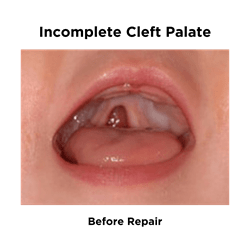
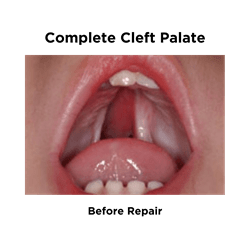
A submucous cleft palate can also occur when the muscles within the soft palate are separated but the skin or mucous membrane is closed. At times the uvula may be bifid, or divided into two parts.
Each year, about 2,500 babies are born with a cleft palate.
With both cleft lip and palate, an opening forms because the facial structure doesn't close completely during development. A child can be born with one or both of these conditions.
What are the different types of cleft lip and cleft palate?
The different types of cleft defects are categorized according to the location of the cleft (unilateral or bilateral) and how much of the lip or palate is involved (incomplete or complete):
- Unilateral defects – the most common type of cleft, affecting one side of the lip, with or without a cleft palate
- Incomplete unilateral cleft lip and/or palate – an opening on one side of the lip that does not extend into the nose, may be accompanied by a cleft palate
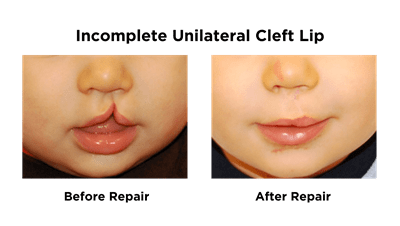
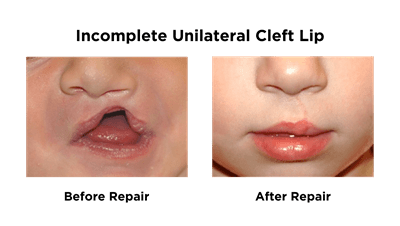
- Complete unilateral cleft lip and/or palate – an opening on one side of the lip that extends up into the nose and may be accompanied by a cleft palate
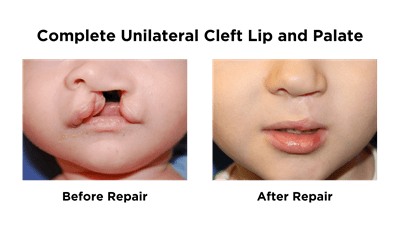
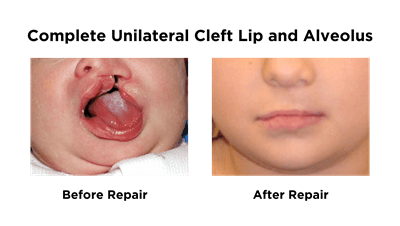
- Bilateral defects – affecting both sides of the lip and/or palate, forming two clefts
- Incomplete bilateral cleft lip and/or palate – openings on both sides of the lip that do not extend into the nose, may be accompanied by a cleft palate
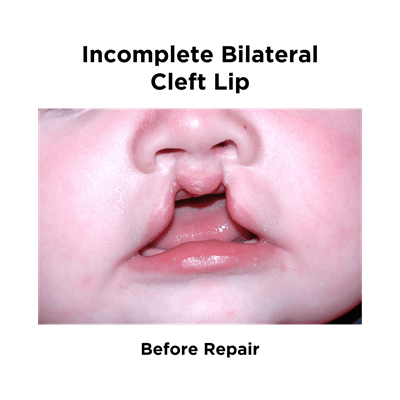
- Complete bilateral cleft lip and/or palate – openings on both sides of the lip that extend up into the nose and may be accompanied by a cleft palate

- Children can also have less noticeable form of cleft lip than those depicted above, known as a forme fruste or microform cleft lip. This is a small, subtle indentation on one or both sides of the lip.
What causes cleft lip and cleft palate?
Both of these conditions form during early pregnancy. Experts aren't sure what causes them, but the conditions could develop if:
- There are changes in the baby's genes
- The mother has a disease, such as diabetes
- The mother uses certain drugs for epilepsy in early pregnancy
- The mother smokes or drinks alcohol in early pregnancy
Who is at risk for cleft lip and cleft palate?
Risk Factors
Both non-preventable factors, such as family history, and lifestyle risks, such as smoking, can increase your chance of having a child with cleft lip or cleft palate. You may be more likely to have a baby with one or both of these conditions if:
- A family member has one of these conditions
- The mother is diabetic
- The mother smoked or drank alcohol in early pregnancy
- The mother used certain medicines in early pregnancy
Complications
Babies with cleft lip or cleft palate may struggle to feed because they can't suck or swallow properly. As the child grows, they may have problems with:
- Hearing
- Teeth development
- Speech
- Social development
Can you prevent cleft lip and cleft palate?
If you're planning to become pregnant, you may be able to reduce the chance of having a child with these conditions by:
- Taking prenatal vitamins
- Avoiding alcohol
- Avoiding smoking
- Talking to your doctor about medicines you're taking
- Making sure you're as healthy as possible before becoming pregnant

















